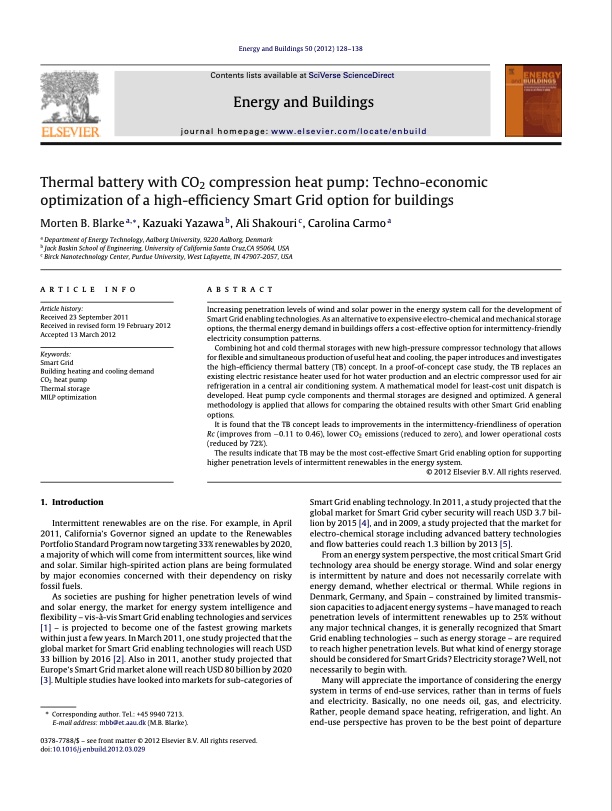
PDF Publication Title:
Text from PDF Page: 001
Energy and Buildings 50 (2012) 128–138 Contents lists available at SciVerse ScienceDirect Energy and Buildings journal homepage: www.elsevier.com/locate/enbuild Thermal battery with CO2 compression heat pump: Techno-economic optimization of a high-efficiency Smart Grid option for buildings Morten B. Blarkea,∗, Kazuaki Yazawab, Ali Shakouric, Carolina Carmoa a Department of Energy Technology, Aalborg University, 9220 Aalborg, Denmark b Jack Baskin School of Engineering, University of California Santa Cruz,CA 95064, USA c Birck Nanotechnology Center, Purdue University, West Lafayette, IN 47907-2057, USA article info Article history: Received 23 September 2011 Received in revised form 19 February 2012 Accepted 13 March 2012 Keywords: Smart Grid Building heating and cooling demand CO2 heat pump Thermal storage MILP optimization 1. Introduction Intermittent renewables are on the rise. For example, in April 2011, California’s Governor signed an update to the Renewables Portfolio Standard Program now targeting 33% renewables by 2020, a majority of which will come from intermittent sources, like wind and solar. Similar high-spirited action plans are being formulated by major economies concerned with their dependency on risky fossil fuels. As societies are pushing for higher penetration levels of wind and solar energy, the market for energy system intelligence and flexibility – vis-à-vis Smart Grid enabling technologies and services [1] – is projected to become one of the fastest growing markets within just a few years. In March 2011, one study projected that the global market for Smart Grid enabling technologies will reach USD 33 billion by 2016 [2]. Also in 2011, another study projected that Europe’s Smart Grid market alone will reach USD 80 billion by 2020 [3]. Multiple studies have looked into markets for sub-categories of ∗ Corresponding author. Tel.: +45 9940 7213. E-mail address: mbb@et.aau.dk (M.B. Blarke). 0378-7788/$ – see front matter © 2012 Elsevier B.V. All rights reserved. doi:10.1016/j.enbuild.2012.03.029 abstract Increasing penetration levels of wind and solar power in the energy system call for the development of Smart Grid enabling technologies. As an alternative to expensive electro-chemical and mechanical storage options, the thermal energy demand in buildings offers a cost-effective option for intermittency-friendly electricity consumption patterns. Combining hot and cold thermal storages with new high-pressure compressor technology that allows for flexible and simultaneous production of useful heat and cooling, the paper introduces and investigates the high-efficiency thermal battery (TB) concept. In a proof-of-concept case study, the TB replaces an existing electric resistance heater used for hot water production and an electric compressor used for air refrigeration in a central air conditioning system. A mathematical model for least-cost unit dispatch is developed. Heat pump cycle components and thermal storages are designed and optimized. A general methodology is applied that allows for comparing the obtained results with other Smart Grid enabling options. It is found that the TB concept leads to improvements in the intermittency-friendliness of operation Rc (improves from −0.11 to 0.46), lower CO2 emissions (reduced to zero), and lower operational costs (reduced by 72%). The results indicate that TB may be the most cost-effective Smart Grid enabling option for supporting higher penetration levels of intermittent renewables in the energy system. © 2012 Elsevier B.V. All rights reserved. Smart Grid enabling technology. In 2011, a study projected that the global market for Smart Grid cyber security will reach USD 3.7 bil- lion by 2015 [4], and in 2009, a study projected that the market for electro-chemical storage including advanced battery technologies and flow batteries could reach 1.3 billion by 2013 [5]. From an energy system perspective, the most critical Smart Grid technology area should be energy storage. Wind and solar energy is intermittent by nature and does not necessarily correlate with energy demand, whether electrical or thermal. While regions in Denmark, Germany, and Spain – constrained by limited transmis- sion capacities to adjacent energy systems – have managed to reach penetration levels of intermittent renewables up to 25% without any major technical changes, it is generally recognized that Smart Grid enabling technologies – such as energy storage – are required to reach higher penetration levels. But what kind of energy storage should be considered for Smart Grids? Electricity storage? Well, not necessarily to begin with. Many will appreciate the importance of considering the energy system in terms of end-use services, rather than in terms of fuels and electricity. Basically, no one needs oil, gas, and electricity. Rather, people demand space heating, refrigeration, and light. An end-use perspective has proven to be the best point of departurePDF Image | Thermal battery with CO2 compression heat pump

PDF Search Title:
Thermal battery with CO2 compression heat pumpOriginal File Name Searched:
Thermal-battery-with-CO2-compression-heat pump.pdfDIY PDF Search: Google It | Yahoo | Bing
CO2 Organic Rankine Cycle Experimenter Platform The supercritical CO2 phase change system is both a heat pump and organic rankine cycle which can be used for those purposes and as a supercritical extractor for advanced subcritical and supercritical extraction technology. Uses include producing nanoparticles, precious metal CO2 extraction, lithium battery recycling, and other applications... More Info
Heat Pumps CO2 ORC Heat Pump System Platform More Info
| CONTACT TEL: 608-238-6001 Email: greg@infinityturbine.com | RSS | AMP |